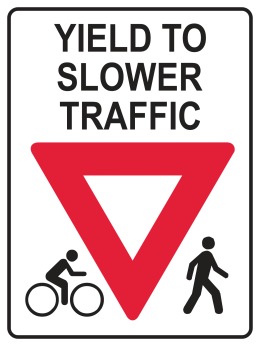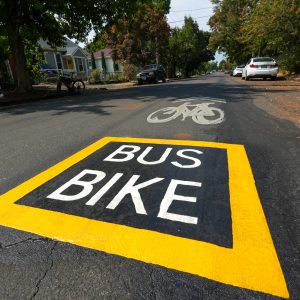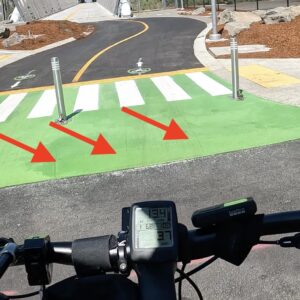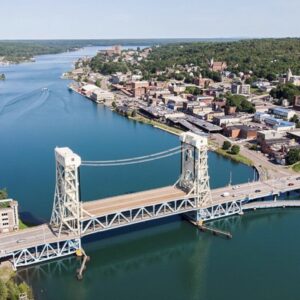
(Photos © J. Maus/BikePortland)
Portland Parks & Recreation has added new pavement markings on the Eastbank Esplanade floating ramps to warn people on bikes to prepare for a bump. The new markings are part of a larger campaign aimed at improving safety of path users.
Back in July of 2010, we brought attention to these jarring bumps after hearing about a friend who had crashed after hitting them. Shortly after that story ran, Parks vowed to evaluate the situation and six months later they installed a less severe “transition strip” to flatten the bumps.
Now Parks has put down a series of pavement markings with the word “BUMP” along with white stripes across the path. I took a closer look at them yesterday and they seem to have an impact. People were noticeably grabbing brakes and slowing down as they approached…



Parks spokesman Mark Ross says the new markings were installed in response to “concerns raised by the Portland bike community,” and are part of a larger effort to improve traffic safety on both the Esplanade and in Waterfront Park.

“We are working in collaboration with PBOT on all of these improvements,” said Ross via email this morning. He added that Parks is collaborating with bike safety experts at PBOT along with a traffic engineer to make sure the markings are consistent with what folks see on the street.”
Other elements of the biking and walking safety effort will include new signs targeted at people on bikes and more pavement markings at “a few key intersections.” The work is expected to be completed by this spring.
Have you seen the “Bump” markings? We’d love to know what you think about them.






Thanks for reading.
BikePortland has served this community with independent community journalism since 2005. We rely on subscriptions from readers like you to survive. Your financial support is vital in keeping this valuable resource alive and well.
Please subscribe today to strengthen and expand our work.
I guess it’s needed, like WAIT, WALK,LOOK both ways!, but it is kind of assuming that riders READ and think about what could happen. I guess my real feeling is that if PBOT is going to spend money on this it would be even better if BUMP would glow at night, like that’s going to happen.
I passed by here last weekend when they were being put down.
Probably a good idea to have it marked. Seems sort of obvious to me, but better safe than sorry I guess, considering the space is shared with joggers, walkers, families, people fishing(!), etc.
I’ve seen the bump markings, but I’d rather see the bumps gone. It’s like putting a steel plate on the road and just leaving it there, with the excuse of “hey, we put up a sign.”
I don’t slow down for the bumps, I just brace myself.
After considering the alternative of trying to swim while carrying my bike through the river… I’ve decided I’m ok with these bumps along our floating multi-use path.
Have you noticed that this is a floating path? I’ll patiently await your engineered solution.
Well, since you asked…
On these same ramps, there is one longer and smoother transition going in each direction. Why not have those same transitions on each current “bump”? Maybe there is a reason they don’t have them on all the transitions, but I haven’t seen it posted.
Because those longer ramps are experimental, and it is apparently a very long experiement.
The bigger issue seems to be not that the bumps exist, but that they change drastically with river level. They are probably most dangerous for occasional Esplanade commuters that think they know what to expect, and then too late realize the transition is twice as steep as usual.
Interesting in that the cognitive load of reading has a longer delay than just reading the terrain as you ride.
That one cannot see the transitions is bizarre to me.
It’s understandable to put a warning that the transitions can become abrupt, but putting text on the surface every x feet is completely redundant.
My parents were in town a couple years back and we rented bikes and rode along the Esplanade. Even though I told them about the bumps coming up they both were still a little shaken by the intensity. You just don’t expect it on a smooth engineered path. It may seem silly to expect that a rider couldn’t extrapolate what to expect from one bump to the next, but some of those riders are 65 year olds who haven’t been on a bike in decades or other types of equally inexperienced riders.
I for one think this was an inexpensive, simple, and helpful thing to do. It does nothing for me, but will likely help others.
My cynical, nasty side likes to think this is just natural selection at work, but it is very true that inexperienced riders have no clue how to unweight the front wheel, nor adjust balance in general, and without doing so you could get your butt kicked on this “recreational path” quite quickly.
fair’nuff. thanks for the insight.
next up: marking all sidewalk curbs with text that reads, “CURB”
Why stop there? How about on every intersection we put a sign that says “STREET”
And carried to its conclusion: a marking on the pavement reading, “PAINT”.
…or a sign on BP postings: “RANT”
more like GROUCH.
I keep wanting them to say JUMP! (at least in the downhill directions)
From the picture, it looks like a couple of these would help: http://www.google.com/products/catalog?q=bump+sign&um=1&ie=UTF-8&tbm=shop&cid=14572840984808892960&sa=X&ei=8DcsT-L-DYOFtgf_sqHnDw&ved=0CG0Q8wIwBg
Or for the gutter-minded among you: http://en.wikipedia.org/wiki/File:Belize_Speed_Bump_Sign.JPG
From down here in Corvallis, I can’t gauge how helpful these will be for cyclists. But I’m predicting that some clever mom-to-be will soon be incorporating them into a posed shot for a baby shower announcement!
Congrats Jonathan, your tireless advocacy on this issue has finally resulted in a long-term solution. Now we can finally move on.
Better to have this new marking than not, I suppose.
But I agree with Toby, above. Would be better to minimise the bumps themselves. Appears that it might just involve a rehash of bracing under one or two plates to make all of the transitions quite smooth.
And I have intimate knowledge of these ramps, as the guy who originally took flight (not so bad – it was the landing that hurt) and brought attention to these things.
It doesn’t seem prohibitively complicated to lengthen the wedges at the end of the ramp, thereby decreases the angle of them (less rise vs run). Not that I’m an engineer or anything, just noting some basic properties of a triangle.
*decreasing
Couple of things for the people that want to get rid of the bumps entirely:
1. The person that crashed did not secure a bungy strap. This could have happened on any pothole or other imperfection in a road.
2. These bumps serve as a way to slow down cyclist. Yes, us cyclist need to slow down as there are pedestrians and joggers on the path.
his bungee broke due to excess G-forces flexing something on the bike. I was there.
Yeah…slow down people!!! Heck, just the other day I saw a speeding cyclist come within meters of injuring a pedestrian with his loose bungee cord.
Excellent shots of the “cratie.” Eugene Bicyclist will be proud…
The bumps are not ADA compliant.
Does anyone know if the Esplanade is ADA-exempt? (Seems it might be exempt if the floating section ramps may exceed 5% slope at low water).
If not, it’s just a matter of sending a maintenance request to SAFE@portlandoregon.gov citing ADA standards section 303, “Changes in Level”
See diagrams 303.2 and 303.3 1/4″ is the maximum “step”, 1/2″ is the maximum beveled step.
http://www.access-board.gov/ada-aba/ada-standards-dot.cfm
And they’ll get on it.
Ted Buehler
I’ve seen them. I ride the area very often so no real change in behavior for me. Good work, I’m assuming it will help those that don’t ride the area often.
Hey, what about that problem spot at SE Salmon (when you are trying to get to the trail by the underpass). Have they done anything about that?
http://bikeportland.org/forum/showthread.php?t=4103&highlight=salmon
Begin rant/
Good lord, people should be paying adequate attention to what is in front of them and moving at a speed that is commensurate with their ability to react and handle a bike. Don’t outride your headlight (Springwater at night with ninjas) or your abilities and expect the path in front of you to be magically cleared and smoothed as you approach. You should always be riding somewhat defensively when in a public right of way with other users.
If a bungee cord comes loose when a bike goes over a good sized bump, then by definition, it wasn’t SECURE. User error.
It seems that we, Portland cyclists who are vocal on this forum, could use a little toughening up sometimes. I know some will say that that attitude won’t attract the “curious, but scared” we so badly need to increase our mode share, but having a more self-reliant attitude is really going to lead to a more satisfied experience than all this coddling.
I agree with the sensible comment above, that it seems more distracting to read the sign on the ground describing the terrain, than to just get to the important part of reading the terrain (which you should be constantly doing).
/rant
The bumps have never been a big deal for me even though my headlight came off last night (I probably did not snap it on completely) and I lost my small wallet after it probably bounced out of a pocket without my knowledge. I jump the bumps, so I blame the jumping, not the bumps.
I think the warning markings, which I can live with or without, are for 1. whiney cyclists and 2. amateur cyclists.
is this satire?
“I think the warning markings, which I can live with or without, are for 1. whiney cyclists and 2. amateur cyclists.”
Portland is trying to become a truly world class biking city. How can not marking the hazards help us get to this goal? As an amateur cyclist (I’ve never received a paycheck for my cycling), I’m glad to see hazards pointed out, they ultimately save money by preventing accidents and injuries.
Riding in Portland shouldn’t be limited to “professional” cyclists.
I wish instead, they’d create lane lines (ala hawthorne bridge) at places like the corners to stay on the concrete at the grated section to the south of the floating path, on the ramp leading up the the rose garden, etc.
I’m tired of near head on collisons with other cyclists cliping the corner. If you’re heading south on the esplanade and decide to stay on the concrete instead of ride the suspeded grate, know that there could very well be a cyclist heading north and has no way of seeing you. Soooo, when you decide to clip the corner, rather than staying to the right, you’re really setting yourself up for an uncofortable impact.
While we’re at it, how about some signs that tell joggers, when there’s 2 of you, how abut not effectvely taking up the whole path. Maybe another sign could say, “when there’s 5 of you, and you’re all running abreast taking up the entire path, and a cyclist is coming towards you and obviously trying to inly take up about 18″ on the far right, maybe you should go ahead and the one of you on your far left, just go ahead and tuck in behind the runner to your right, because something’s got to give.” Although, notw that I think about it, that sign would be huge and competely ignored as I’m sure when they came across that sign, there favorite song would be coming on thier iPod that they have turned up to 7.
Okay, done with the rant, but I do with they’d put lanes on the problematic corners.
There has been discussion about trying to engineer out the shock of the bumps using long ramps. That’s all well and good, until the river naturally floods in winter / spring. No amount of engineering is going to minimize bumps on that ramp when the river is at 16-feet on the Morrison gauge.
Better to engineer the cheap, “good for most situations” solution than something more expensive that seems only appropriate at lower river levels.
And yes, not everyone on that path is a pro cyclist. Warning strips to those that haven’t been on a bike in years is likely a good thing to give them warning. Doubtful tourists are flying through that section anyhow, and would have time to be able to read the warnings.
Would be nice if there was advance warning on that instead of just putting it at the obstacle itself, as required by the MUTCD.
This is a welcome improvement for bikes and peds alike. Thank you, Portland Parks + PBOT!
I just saw the new paint signage today, and i think the word + stripe is a decent warning for folks who don’t ride this path every day. i noticed it very clearly after not having been there in a while.
JM’s photos show nicely that there is little visual contrast between the ramps and the walk surface itself
my humble suggested improvement would be to color the ramps differently than the normal “ground” surface; it wouldn’t have to be glaring neon, just high contrast (zebra stripe ramp maybe?)
I believe a black background would have been an ideal application here.
Why don’t we just start bringing in lawyers to sue every entity associated with every bike facility that is not beyond perfect. That will fix things
huh?
Something for those whining about the “whiners” to think about:
Is this a path designed for vehicular travel, recreational or otherwise? (answer: Yes.)
Now think about other “pathways” designed for vehicular travel, e.g., roads designed for motor vehicles…
…are there ever obstacles like this designed into those roadways? (answer: Yes.)
…are such designed-in obstacles, such as chicanes or speed bumps ever unmarked? (answer: No, or only due to error or vandalism)
On NO other type of vehicular travelway would this kind of unmarked obstacle be tolerated for one day, let alone years. The markings are absolutely appropriate and necessary; I don’t know how it could have been legal to have left them unmarked for so long.
To those who say the bumps are good because they slow down cyclists, well so do potholes, tripwires, and carpet tacks in the road; are those things “good”? If a bump is legally designed into the path with the express purpose of slowing people down (or even if it isn’t), it should be marked clearly just as any speed bump or hump on a residential street would be.